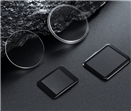

Time:2024-12-23
Sapphire watch mirrorWith its hardness, transparency, and elegant luster, it has become a protective shield for watches. This material, made of artificially synthesized alumina crystals, is not only scratch resistant and wear-resistant, but also has unique optical properties that make the flow of time appear clearer and deeper in every inch. However, it is precisely this exterior that hides the almost stringent pursuit of surface accuracy and smoothness, as well as a series of complex and refined surface treatment processes. Among them, the grinding process, as a key link, is divided into two stages: rough grinding and fine grinding, each of which embodies wisdom and sweat.
1、 Rough grinding
As the starting point for surface treatment of sapphire mirrors, rough grinding aims to remove rough edges and uneven surfaces left during the cutting process, laying a solid foundation for subsequent fine grinding. This process is like a sculptor carving raw stones for the first time, requiring careful and powerful techniques. Select abrasive with larger particle size and use suitable grinding tools to preliminarily polish the sapphire crystal with a certain pressure and speed.
Temperature control is particularly crucial in this process. Due to the high hardness of sapphire material, if the heat generated by friction is not dissipated in a timely manner, it may cause stress inside the mirror and even affect its physical properties. Therefore, professional grinding equipment is equipped with an efficient cooling system to ensure that the temperature during the grinding process remains within a safe range.
With the continuous wear and replacement of abrasives, the surface of sapphire mirrors gradually becomes flat, but there are still subtle scratches and roughness, which is the sign of the end of the rough grinding process and the signal of the start of the fine grinding process.

2、 Fine grinding
If rough grinding is about laying the foundation, then fine grinding is about building bricks and refining the surface of sapphire mirrors. During this process, the particle size of the abrasive is significantly reduced, and the selection of tools is more particular to ensure that the traces left by rough grinding are further removed without damaging the mirror structure, thereby improving the smoothness and flatness of the surface.
The technical difficulty of precision grinding is much higher than that of rough grinding, which requires workers not only to have rich experience, but also to have high patience and concentration. Every subtle adjustment is directly related to the quality of the finished product. In order to achieve the desired grinding effect, workers often need to repeatedly experiment and adjust the grinding parameters until they find a suitable grinding solution for the current mirror.
As time goes by, the surface of the sapphire watch mirror gradually presents a mirror like luster, and every detail shines with the wisdom and hard work of the craftsman. However, this is not the end point, but a new starting point towards higher quality. In the following polishing process, the surface of the watch mirror will undergo a more delicate treatment, bringing visual enjoyment and comfortable wearing experience to the wearer.
3、 The Art of Surface Treatment
The surface treatment of sapphire watch mirrors is not only a technical activity, but also an art. It combines the precision and efficiency of modern technology with the delicacy and delicacy of traditional craftsmanship. Behind the automated and intelligent production lines, there are countless craftsmen who tirelessly pursue and persistently adhere to quality. Transforming cold sapphire crystals into wristwatch masterpieces that carry the story of time and showcase taste.
The high requirements for surface accuracy and smoothness of sapphire watch mirrors not only drive the continuous progress of watchmaking technology, but also the combination of technology and craftsmanship. In this process, every detail is crucial, and every grinding carries a commitment to quality.






Tel
Mobile phone
Customer service
TOP